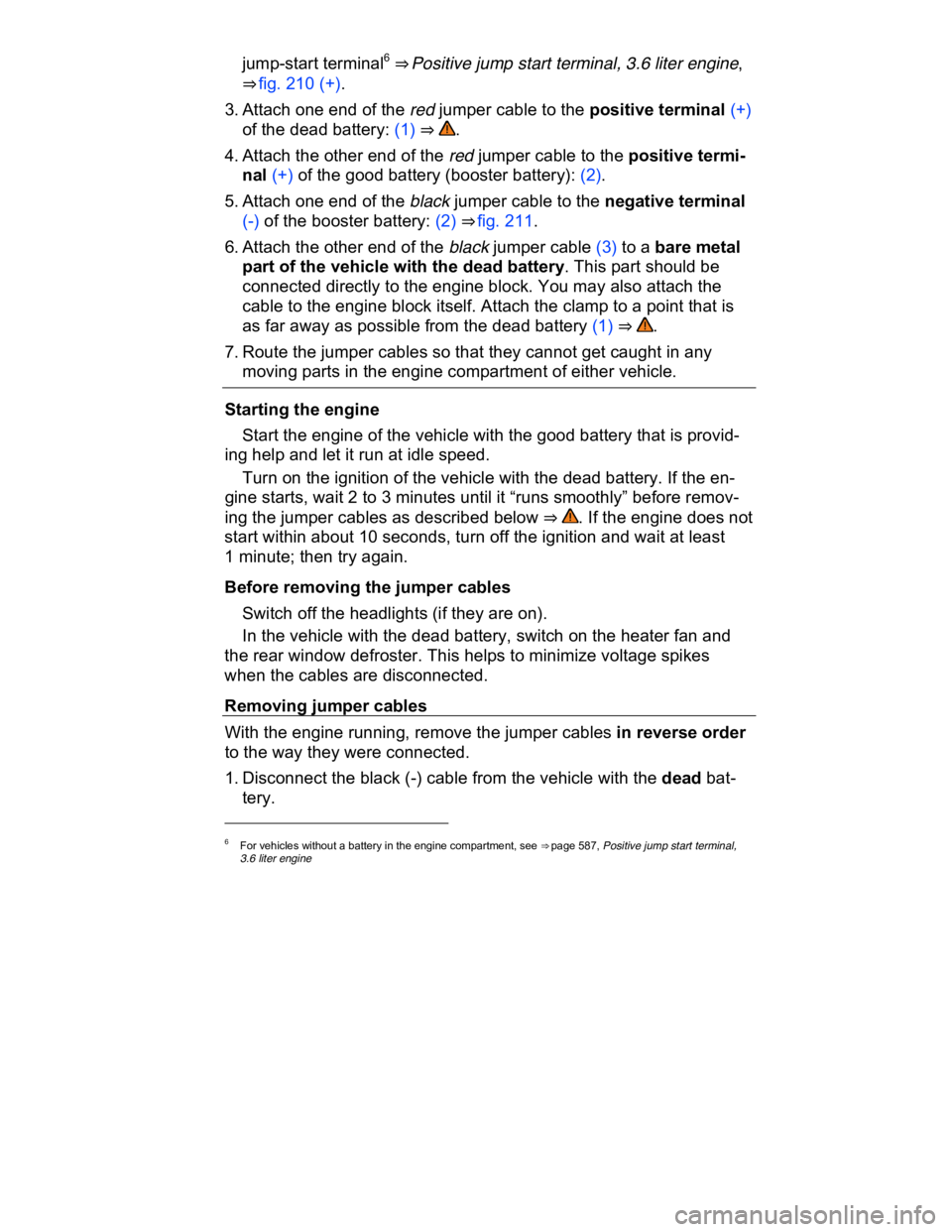jump-start terminal6 ⇒ Positive jump start terminal, 3.6 liter engine,
⇒ fig. 210 (+).
3. Attach one end of the red jumper cable to the positive terminal (+)
of the dead battery: (1) ⇒ .
4. Attach the other end of the red jumper cable to the positive termi-
nal (+) of the good battery (booster battery): (2).
5. Attach one end of the black jumper cable to the negative terminal
(-) of the booster battery: (2) ⇒ fig. 211.
6. Attach the other end of the black jumper cable (3) to a bare metal
part of the vehicle with the dead battery. This part should be
connected directly to the engine block. You may also attach the
cable to the engine block itself. Attach the clamp to a point that is
as far away as possible from the dead battery (1) ⇒ .
7. Route the jumper cables so that they cannot get caught in any
moving parts in the engine compartment of either vehicle.
Starting the engine
� Start the engine of the vehicle with the good battery that is provid-
ing help and let it run at idle speed.
� Turn on the ignition of the vehicle with the dead battery. If the en-
gine starts, wait 2 to 3 minutes until it “runs smoothly” before remov-
ing the jumper cables as described below ⇒ . If the engine does not
start within about 10 seconds, turn off the ignition and wait at least
1 minute; then try again.
Before removing the jumper cables
� Switch off the headlights (if they are on).
� In the vehicle with the dead battery, switch on the heater fan and
the rear window defroster. This helps to minimize voltage spikes
when the cables are disconnected.
Removing jumper cables
With the engine running, remove the jumper cables in reverse order
to the way they were connected.
1. Disconnect the black (-) cable from the vehicle with the dead bat-
tery.
6 For vehicles without a battery in the engine compartment, see ⇒ page 587, Positive jump start terminal, 3.6 liter engine
Abbreviations
Abbreviation Meaning
ABS Anti-lock Brake System
AFS Adaptive Front Lighting System
AKI Anti-Knock Index
ANSI American National Standards Institute
ASR Anti-Slip Regulation
ATA Anti-Theft Alarm system
BAS Brake Assist System
ccm Cubic centimeter – metric unit of measure for engine
displacement
CCS Cruise Control System
CID Cubic inch displacement – unit of measure for engine
displacement
cm Centimeter – metric unit of measure for length
CO2 Carbon dioxide
DIN Deutsches Institut für Normung (German Institute for
Standardization)
DRL Daytime Running Lights
DSG® Direct Shift Gearbox automatic transmission
EDL Electronic Differential Lock
EN European Norm
EPC Engine control (Electronic Power Control)
ESC Electronic Stability Control
g/km Generated carbon monoxide amount in grams per
kilometer driven
GAWR Gross Axle Weight Rating
GVWR Gross Vehicle Weight Rating
HID High Intensity Discharge headlights (Xenon)

